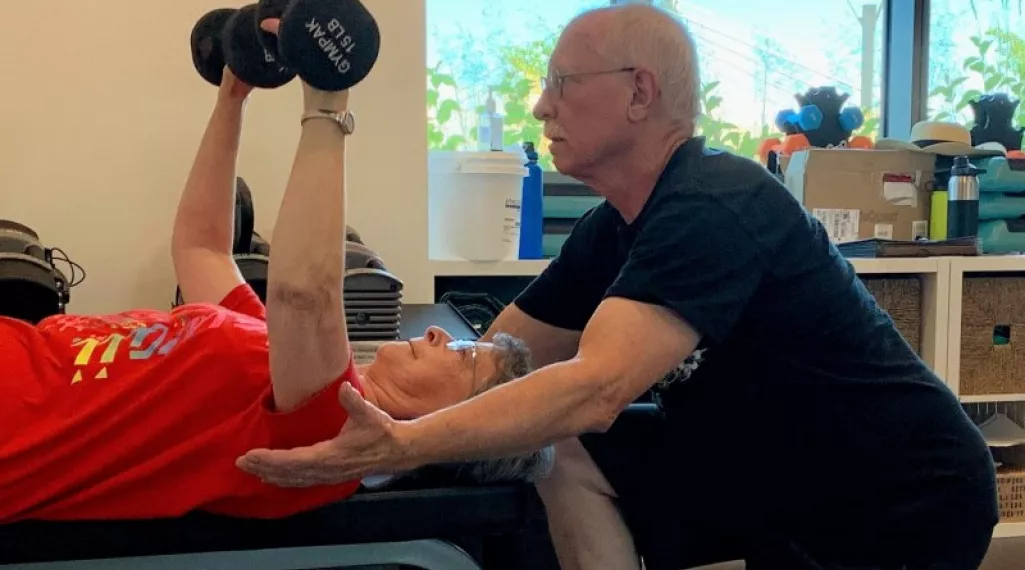3X Match My Gift
Act now through 12/31! Triple your impact to support colorectal cancer patients, survivors, and caregivers.


Contributed by Kerri Winters-Stone, PhD, FACSM
With the wide array of cancer treatments used to treat colorectal cancer, many survivors are left dealing with side effects that could last months or years. These side effects could potentially be lessened with regular exercise, but survivors can also have fear or uncertainty towards exercise during and after treatment. Questions such as, “Is exercise safe?”, “What type of exercise is best?”, “How much exercise should I do?” and “Where do I start?” can become barriers to getting and staying active. These questions are compounded by confusion around advice from healthcare professionals to avoid lifting and abdominal exercises in persons who have had stoma surgery.
To start tackling some of these questions, let’s start with addressing the safety of exercise.
According to a recent meta-analysis examining all currently published exercise intervention trials in colorectal cancer survivors, exercise is generally safe and beneficial during and after treatment for colorectal cancer (1). Only 1% of participants in all studies had any sort of undesirable health or medical-related event from exercise and these “events” reflected normal responses a new exerciser might experience (e.g. muscle soreness).
Not only did this article deem exercise as safe, but it also showed exercise was effective at reducing certain side effects from treatment including improved quality of life, fitness, muscle strength, and sleep, as well as lessened fatigue, depressive symptoms, and body fat. Even though research has shown exercise to be generally safe for persons with colorectal cancer, persons who have had stoma surgery would be advised to work with a physical therapist or certified cancer exercise trainer (see link at the end of this blog) when starting a new exercise program.
In 2019, a large number of high-quality research studies showing the benefit of exercise on treatment-related side effects across many cancer types led experts in the American College of Sports Medicine to shift from a general one-size-fits-all recommendation for exercise (150 minutes of aerobic activity and twice-weekly resistance exercise) toward more specific exercise guidelines to improve common side effects from cancer treatment. These new guidelines answer the questions of “What type of exercise is best?” and “How much exercise is needed”? (2).
The guidelines show that, in general, it doesn’t take much exercise to make a difference. To improve anxiety, depression, fatigue, quality of life, and physical functioning (ability to do your day-to-day activities with ease), a survivor should aim for 30 minutes of moderate-intensity aerobic exercise three times per week. Alternatively, the same benefit can be achieved with a combination of 30 minutes of moderate-intensity aerobic exercise plus resistance training (15 minutes of each) or 30 minutes of resistance training three times a week.
These new guidelines, showing that less exercise is enough to feel better, are meant to inspire people to get more physically active after cancer treatment. Survivors may also be encouraged by research that shows regular physical activity after treatment might lower the risk of colorectal cancer recurrence and lower the risk of dying from colorectal cancer.
Even more interesting, data is suggesting that getting enough physical activity after diagnosis may be as helpful, if not more so, for reducing death rates than being active before a diagnosis of cancer (3). So, there is no better time than the present to think about getting more exercise, even if you have never been physically active before.
If physical activity is new to you, remember to start low and progress slow! Find an activity you enjoy (e.g. walking, cycling, swimming) and start with 10 minutes of activity three times a week, slowly working your way up to the minimum recommendation of 30 minutes three times a week.
One approach is to add a few minutes each week to your routine. Within a couple of months, you can safely reach recommended goals. If you are already meeting the minimum recommendation, consider adding an extra day of physical activity, as there is evidence that higher volumes of aerobic exercise (up to 180min/week) can lead to better symptom reduction and possibly better longevity.
If exercise still feels daunting for you, then at the very least try to avoid being completely inactive. Research shows over and over again that sitting all day, even if you still engage in planned exercise, can increase your risk for chronic diseases and various cancers (3). Try to plan five-minute standing or moving breaks within every hour that you sit at a desk or elsewhere. Engineer movement into your daily life as much as you can, by walking instead of driving, doing tasks by hand instead of using machines (ditch your Roomba!), and adding some leisure activities to your day.
For more general information on exercise and cancer survivorship, we recommend visiting the American College of Sports Medicine’s Moving Through Cancer website.
Dr. Kerri Winters-Stone, is an exercise scientist, co-director of the Knight Community Partnership Program and co-program leader of the Cancer Prevention and Control Program for the OHSU Knight Cancer Institute. Dr. Winters-Stone’s research focuses on the effects of cancer treatment on musculoskeletal health and cancer recurrence risk and the ability of exercise to improve health and longevity in cancer survivors. Her passion lies in forging new directions in her research and has extended her work in to studying the impact of cancer treatment on the health of intimate partners and relationships by innovating a partnered approach to resistance exercise that builds teamwork. Using teamwork, health and functioning of each partner and their relationship could be optimized leading to better outcomes for the couple. You can follow Dr. Winters-Stone on Twitter: @winters_stone
References:
1. Singh, B, Hayes SC, Spence RR, Steele ML, Millet GY, Gergele L. Exercise and colorectal cancer: a systematic review and meta-analysis of exercise safety, feasibility and effectiveness. International Journal of Behavioral Nutrition and Physical Activity. 2020;17:122
2. Campbell KL, Winters-Stone KM, Wiskemann J, May AM, Schwartz AL, Courneya KS, Zucker DS, Matthews CE, Ligibel JA, Gerber LH, Morris GS, Patel AV, Hue TF, Perna FM, Schmitz KH. Exercise Guidelines for Cancer Survivors: Consensus Statement from International Multidisciplinary Roundtable. Med Sci Sports Exerc. 2019 Nov;51(11):2375-2390. doi: 10.1249/MSS.0000000000002116. PMID: 31626055.
3. Patel AV, Friedenreich CM, Moore SC, Hayes SC, Silver JK, Campbell KL, Winters-Stone K, Gerber LH, George SM, Fulton JE, Denlinger C, Morris GS, Hue T, Schmitz KH, Matthews CE. American College of Sports Medicine Roundtable Report on Physical Activity, Sedentary Behavior, and Cancer Prevention and Control. Med Sci Sports Exerc. 2019 Nov;51(11):2391-2402. doi: 10.1249/MSS.0000000000002117. PMID: 31626056; PMCID: PMC6814265.

“When I was diagnosed, I needed more than information — I needed connection,” Damien said. “The Alliance was a lifeline."

After a stage IV colorectal cancer diagnosis, Heather’s biomarker test revealed a critical mutation — opening the door to clinical trials and new hope.

Watch videos of two major general sessions from AllyCon 2024, the Alliance's patient support conference, which took place in Miami Beach in December.